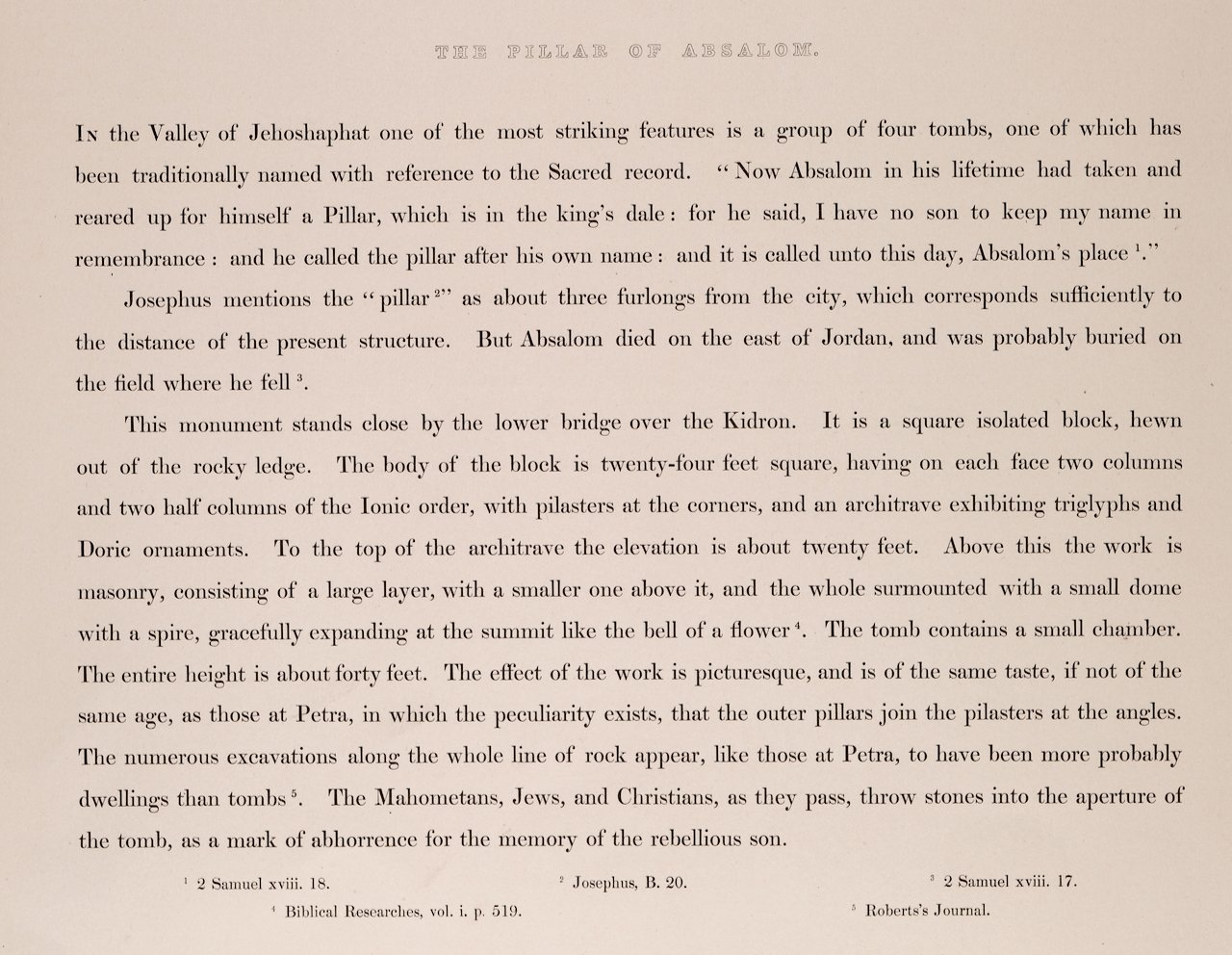Pillar of Absalom near Jerusalem: David Roberts' 19th C. Hand-colored Lithograph
This is an original 19th century hand-colored lithograph entitled "Absaloms Pillar, Valley of Schoshaphat" by David Roberts, from his Egypt and Nubia volumes of the large folio edition, published in London by F. G. Moon in 1841. The lithographs were prepared by Louis Haghe (1806-1885) from drawings and paintings by Roberts. The resultant large folio editions of 'The Holy Land' and 'Egypt & Nubia' are considered among the greatest lithographically illustrated works issued in the 19th century.
Creator: David Roberts (1796-1864, British)
Creation Year: 1841
Dimensions: Height: 23.88 in (60.66 cm)
Width: 17 in (43.18 cm)
Medium: Lithograph
Condition: See description below.
Reference #: 2815
This is an original 19th century hand-colored lithograph entitled "Absaloms Pillar, Valley of Schoshaphat" by David Roberts, from his Egypt and Nubia volumes of the large folio edition, published in London by F. G. Moon in 1841. The lithographs were prepared by Louis Haghe (1806-1885) from drawings and paintings by Roberts. The resultant large folio editions of 'The Holy Land' and 'Egypt & Nubia' are considered among the greatest lithographically illustrated works issued in the 19th century.
Creator: David Roberts (1796-1864, British)
Creation Year: 1841
Dimensions: Height: 23.88 in (60.66 cm)
Width: 17 in (43.18 cm)
Medium: Lithograph
Condition: See description below.
Reference #: 2815
This is an original 19th century hand-colored lithograph entitled "Absaloms Pillar, Valley of Schoshaphat" by David Roberts, from his Egypt and Nubia volumes of the large folio edition, published in London by F. G. Moon in 1841. The lithographs were prepared by Louis Haghe (1806-1885) from drawings and paintings by Roberts. The resultant large folio editions of 'The Holy Land' and 'Egypt & Nubia' are considered among the greatest lithographically illustrated works issued in the 19th century.
Creator: David Roberts (1796-1864, British)
Creation Year: 1841
Dimensions: Height: 23.88 in (60.66 cm)
Width: 17 in (43.18 cm)
Medium: Lithograph
Condition: See description below.
Reference #: 2815
This page from Roberts' 19th century publication includes a half-folio hand-colored lithograph of a view of one of a group of four tombs outside the walls of the old city of Jerusalem. This tomb is known as the Pillar of Absalom. It depicts the pillar atop a square structure with columns, which remains half buried in the rocky slope of the Mount of Olives. A bridge crosses a ravine on the right. Arab men are seen in the foreground in their colorful native costumes, including a pair of guards who are sitting on the slope next to the tomb. The lithograph is titled in the plate in the lower center in Roberts' own script; "Absaloms Pillar, Valley of Schoshaphat".
The so-called 'Tomb of Absalom' is located at the Mount of Olives in the Kidron Valley, near Jerusalem. Local tradition dating back to at least the Byzantine era ascribes the tomb to Absalom, the rebellious son of King David. This is based on a description in the bible's Book of Samuel of a pillar that Absalom caused to be set up as a memorial to himself, owing to his lack of sons to carry on his name. In fact, the tomb was more likely built during the first century AD, at a similar time to other nearby tombs in the Kidron Valley. The identification of the tomb's actual purpose is not known for sure, but it has been suggested that it may once have been the burial place of Herod Agrippa, since it is similar to the architectural style of the tomb of Herod the Great, Agrippa's grandfather. The tomb's burial-chamber is cut directly from the rock of the Mount of Olives. Architecturally, it is typical of the Eastern Hellenistic style of the first century AD, with a combination of Ionic, Doric, and Egyptian components. Muslims gave the tomb the Arabic name Tantur Fir'aun, "Pharaoh's Hat", due to the shape of its dome. In his textual description, Roberts notes the structures similarities to the architecture of those tombs found at Petra in Jordan. The lower portion of the page contains text from Roberts journal. This print can be displayed in its entirety, including both the lithograph and the text. Another option is to frame only the lithographic image. The text could be displayed on the back of the frame, perhaps glazed.
David Roberts (1796-1864) was born outside of Edinburgh, Scotland. At age 10 he became a house painter’s apprentice. He continued painting houses and eventually theater scenes in Edinburgh and then in London. His friend, J. M. W. Turner, recognized his artistic talent and encouraged him to become a full-time artist.
In 1839 Roberts traveled to Egypt and then in 1840, through the Holy Land, concluding in Jerusalem. Upon his return to England, F. G. Moon agreed to publish lithographs created by Louis Haghe from Robert’s sketches and watercolors. This publication was highly acclaimed and very popular for its esthetic quality, its historical and topographical accuracy, and Robert’s dramatic depiction of his scenes. Queen Victoria and Charles Dickens were among the subscribers who collected his works. Roberts' and Haghe’s duotone lithographs, often colored, remain extremely sought-after today and have been rising steadily in value.

























